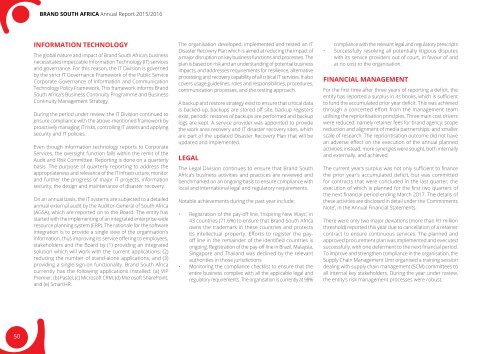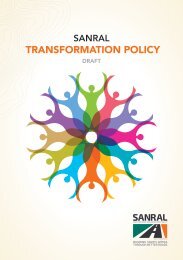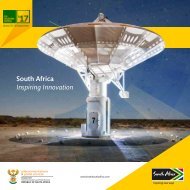Brand-South Africa - Annual report 2015 - 2016
During the past financial year, aligned with its mandate to build pride and patriotism in the Nation Brand, Brand South Africa has worked on initiatives to encourage active citizenship in partnership with its stakeholders in government, business, civil society and identified influential forums to increase the participation of all people, particularly our young people, in building a strong, cohesive Nation Brand. These activities, together with engagements at provincial level on Nation Brand alignment, contribute to social cohesion and a positive Nation Brand. Brand South Africa’s activities took place under the leadership of its new CEO, Amb. Kingsley Makhubela, PhD, who joined the organisation during the year.
During the past financial year, aligned with its mandate to build pride and patriotism in the Nation Brand, Brand South Africa has worked on initiatives to encourage active citizenship in partnership with its stakeholders in government, business, civil society and identified influential forums to increase the participation of all people, particularly our young people, in building a strong, cohesive Nation Brand. These activities, together with engagements at provincial level on Nation Brand alignment, contribute to social cohesion and a positive Nation Brand.
Brand South Africa’s activities took place under the leadership of its new CEO, Amb. Kingsley Makhubela, PhD, who joined the organisation during the year.
You also want an ePaper? Increase the reach of your titles
YUMPU automatically turns print PDFs into web optimized ePapers that Google loves.
and south africa <strong>Annual</strong> Report <strong>2015</strong>/<strong>2016</strong><br />
Information Technology<br />
The global nature and impact of <strong>Brand</strong> <strong>South</strong> <strong>Africa</strong>’s business<br />
necessitates impeccable Information Technology (IT) services<br />
and governance. For this reason, the IT Division is governed<br />
by the strict IT Governance Framework of the Public Service<br />
Corporate Governance of Information and Communication<br />
Technology Policy Framework. This framework informs <strong>Brand</strong><br />
<strong>South</strong> <strong>Africa</strong>’s Business Continuity Programme and Business<br />
Continuity Management Strategy.<br />
During the period under review, the IT Division continued to<br />
ensure compliance with the above-mentioned framework by<br />
proactively managing IT risks, controlling IT assets and applying<br />
security and IT policies.<br />
Even though information technology <strong>report</strong>s to Corporate<br />
Services, the oversight function falls within the remit of the<br />
Audit and Risk Committee. Reporting is done on a quarterly<br />
basis. The purpose of quarterly <strong>report</strong>ing to address the<br />
appropriateness and relevance of the IT infrastructure, monitor<br />
and further the progress of major IT projects, information<br />
security, the design and maintenance of disaster recovery.<br />
On an annual basis, the IT systems are subjected to a detailed<br />
annual external audit by the Auditor-General of <strong>South</strong> <strong>Africa</strong><br />
(AGSA), which are <strong>report</strong>ed on to the Board. The entity has<br />
started with the implementing of an integrated enterprise-wide<br />
resource planning system (ERP). The rationale for the software<br />
integration is to provide a single view of the organisation’s<br />
information, thus improving its service offering to employees,<br />
stakeholders and the Board by (1) providing an integrated<br />
solution which will work with the current applications; (2)<br />
reducing the number of stand-alone applications; and (3)<br />
providing a single-sign-on functionality. <strong>Brand</strong> <strong>South</strong> <strong>Africa</strong><br />
currently has the following applications installed: (a) VIP<br />
Premier; (b) Pastel; (c) Microsoft CRM; (d) Microsoft SharePoint;<br />
and (e) SmartHR.<br />
The organisation developed, implemented and tested an IT<br />
Disaster Recovery Plan which is aimed at reducing the impact of<br />
a major disruption on key business functions and processes. The<br />
plan is based on risk and an understanding of potential business<br />
impacts, and addresses requirements for resilience, alternative<br />
processing and recovery capability of all critical IT services. It also<br />
covers usage guidelines, roles and responsibilities, procedures,<br />
communication processes, and the testing approach.<br />
A backup and restore strategy exist to ensure that critical data<br />
is backed-up, backups are stored off site, backup registers<br />
exist, periodic restores of backups are performed and backup<br />
logs are kept. A service provider was appointed to provide<br />
the work area recovery and IT disaster recovery sites, which<br />
are part of the updated Disaster Recovery Plan that will be<br />
updated and implemented.<br />
Legal<br />
The Legal Division continues to ensure that <strong>Brand</strong> <strong>South</strong><br />
<strong>Africa</strong>’s business activities and practices are reviewed and<br />
benchmarked on an ongoing basis to ensure compliance with<br />
local and international legal and regulatory requirements.<br />
Notable achievements during the past year include:<br />
• Registration of the pay-off line, ‘Inspiring New Ways’, in<br />
43 countries (71.6%) to ensure that <strong>Brand</strong> <strong>South</strong> <strong>Africa</strong><br />
owns the trademark in these countries and protects<br />
its intellectual property. Efforts to register the payoff<br />
line in the remainder of the identified countries is<br />
ongoing. Registration of the pay-off line in Brazil, Malaysia,<br />
Singapore and Thailand was declined by the relevant<br />
authorities in those jurisdictions<br />
• Monitoring the compliance checklist to ensure that the<br />
entire business complies with all the applicable legal and<br />
regulatory requirements. The organisation is currently at 98%<br />
compliance with the relevant legal and regulatory prescripts<br />
• Successfully resolving all potentially litigious disputes<br />
with its service providers out of court, in favour of and<br />
at no cost to the organisation.<br />
Financial Management<br />
For the first time after three years of <strong>report</strong>ing a deficit, the<br />
entity has <strong>report</strong>ed a surplus in its books, which is sufficient<br />
to fund the accumulated prior year deficit. This was achieved<br />
through a concerted effort from the management team<br />
utilising the reprioritisation principles. Three main cost drivers<br />
were reduced, namely retainer fees for brand agency; scope<br />
reduction and alignment of media partnerships; and smaller<br />
scale of research. The reprioritisation outcome did not have<br />
an adverse effect on the execution of the annual planned<br />
activities; instead, more synergies were sought, both internally<br />
and externally, and achieved.<br />
The current year’s surplus was not only sufficient to finance<br />
the prior year’s accumulated deficit, but was committed<br />
for contracts that were concluded in the last quarter, the<br />
execution of which is planned for the first two quarters of<br />
the next financial period ending March 2017. The details of<br />
these activities are disclosed in detail under the ‘Commitments<br />
Note’, in the <strong>Annual</strong> Financial Statements.<br />
There were only two major deviations (more than R1 million<br />
threshold) <strong>report</strong>ed this year due to cancellation of a retainer<br />
contract to ensure continuous services. The planned and<br />
approved procurement plan was implemented and executed<br />
successfully, with one deferment to the next financial period.<br />
To improve and strengthen compliance in the organisation, the<br />
Supply Chain Management Unit organised a training session<br />
dealing with supply chain management (SCM) committees to<br />
all internal key stakeholders. During the year under review,<br />
the entity’s risk management processes were robust.<br />
50











